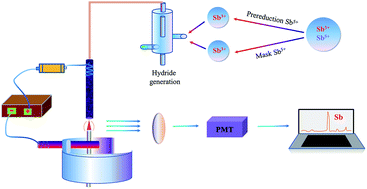Ultra-sensitive determination of antimony valence by solution cathode glow discharge optical emission spectrometry coupled with hydride generation
Abstract
An ultra-sensitive solution cathode glow discharge-optical emission spectrometry (SCGD-OES) method coupled with hydride generation (HG) for the determination of antimony valence is described. Through masking Sb(V) with citric acid in HCl medium, stibine from Sb(III) was selectively generated in a hydride generation system. Total antimony was determined after reducing Sb(V) to Sb(III) with 0.3% L-cysteine in 0.01 mol L−1 HCl. The Sb(V) concentration was calculated from the difference between total antimony and Sb(III). The main operational parameters and sources of potential interference that affect the determination were optimized with Sb(III) standard solution. The limits of detection (LODs) were 0.39 and 0.36 ng mL−1 for Sb(III) and total antimony, respectively, and the RSDs were 2.1 and 1.7% at the 10 ng mL−1 level, respectively. This method was applied for determining the valence of antimony in real water samples, and recovery experiments for different amounts of analytes were carried out. The recoveries were all in the range of 96.2–103.2% and were in good agreement with the corresponding ICP-MS values.



 Please wait while we load your content...
Please wait while we load your content...